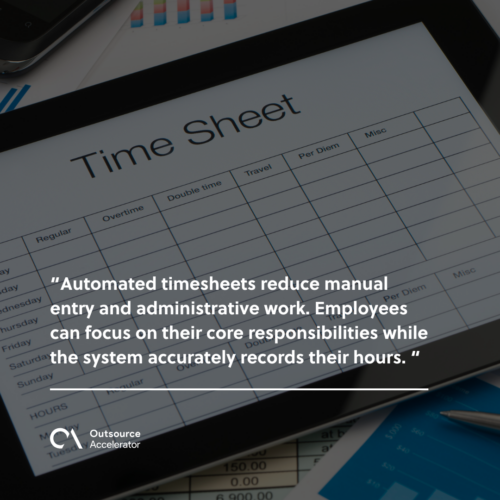Remote employee time tracking: How to choose the right software
Remote employee time tracking: Your simple guide to choosing software
An increasing number of businesses are relying on remote workers to stay agile, reduce costs, and operate around the clock. Hiring talent across borders has evolved from a trend to a strategic necessity in the fast-paced global economy.
As Ruffy Galang, CEO of Remote Employee, described to Rolling Stone, “Outsourcing is no longer just an option; it’s becoming necessary for businesses that want to stay competitive.”
While remote teams offer flexibility and access to global talent, managing them effectively presents significant challenges, particularly in terms of productivity and accountability.
Tracking hours, monitoring progress, and aligning teams across time zones can overwhelm even seasoned managers.
This article breaks down everything leaders need to know about remote employee time tracking. We’ll discuss the important features to look for to streamline operations. The right time tracking tool can transform how businesses lead remote employees.
Remote employee time tracking: 7 essential features to look for
Remote work demands efficient time tracking tools that promote accountability, productivity, and transparency. Investing in the right software can significantly improve team performance and project management.
Here are seven key features to consider when selecting a time tracking solution for offshored teams:
Real-time tracking
Real-time tracking enables managers to view work progress as it occurs. It provides a clear picture of how time is spent across tasks and projects, making it easier to identify workflow bottlenecks or time-consuming activities.
Automated timesheets
Automated timesheets reduce manual entry and administrative work. Employees can focus on their core responsibilities while the system accurately records their hours.
This feature also simplifies payroll processing and report generation.

Activity monitoring
Activity monitoring tools capture app usage, keyboard strokes, and mouse movements during work hours. These insights provide visibility into employee engagement without requiring constant check-ins, thereby fostering a balanced work environment.
Project and task management
Integrated task and project management features allow teams to assign, track, and complete tasks within a single platform.
Alignment between time tracking and project goals helps remote teams stay organized and meet deadlines efficiently.
Customizable reporting
Customizable reports present time data in formats that suit different business needs. Managers can generate summaries based on projects, team members, or specific time periods to support decision-making and resource planning.
Offline tracking
Offline tracking records work even when the internet connection is unstable. Once reconnected, the system automatically syncs data, enabling remote employees in different locations or time zones to remain productive.
Integration capabilities
Compatibility with other tools (i.e., project management software, payroll systems, and communication platforms) streamlines operations. Seamless integration creates a centralized workflow, reducing the need to switch between multiple applications.
Selecting a time tracking solution with these features strengthens remote team management and promotes efficient, transparent work practices.
Important considerations before integrating remote employee time tracking
Integrating a time tracking system into a remote work environment requires thoughtful planning. To support productivity and transparency, businesses must evaluate several factors before adopting new tools.
Below are important considerations that can guide a smooth and effective implementation:
Company goals and workflow
Identifying the organization’s specific goals helps determine how time tracking fits into existing operations.
Whether the focus is on improving accountability, streamlining billing, or managing project timelines, the chosen system should align with daily workflows.
Employee privacy
Employee privacy is crucial in fostering trust and reducing resistance to micromanaging. Respecting employees’ privacy helps create a healthy work environment and boosts morale.
Time tracking should strike a balance between gaining productivity insights and respecting personal boundaries, especially in remote setups where the lines between work and home life often blur.
It helps avoid the pitfalls of micromanagement, which can undermine employee autonomy and trust.
Legal compliance
Different regions have varying labor laws regarding tracking work hours and employee monitoring.
Reviewing these regulations before implementation helps prevent legal complications and supports ethical practices.
Team communication
Introducing a new time tracking system requires clear communication to the remote team you’re managing. Employees should understand why the tool is being adopted, how it works, and what benefits it brings.
Transparent dialogue fosters cooperation and reduces misunderstandings.
System usability
A user-friendly platform encourages consistent use. Tools with a simple interface and intuitive features help remote workers focus on their tasks rather than navigating complex software.
Scalability
The chosen solution should accommodate business growth. As teams expand or new departments form, the time tracking system must adapt without disrupting operations or requiring frequent upgrades.

Data security
Time tracking tools handle sensitive employee data. Selecting software with strong security measures protects information and maintains professional integrity across remote teams.
Evaluating these factors before integrating time tracking helps businesses adopt tools that support both employee satisfaction and operational efficiency.
Tap into high-performing virtual staff through Remote Employee
Discover top-tier virtual talent that drives productivity and growth. Remote Employee connects businesses to skilled professionals ready to deliver results across various roles. Tap into high-performing staff who can adapt to your goals.
By partnering with Remote Employee, companies not only access top-tier talent but also enjoy reduced costs, improved operational efficiency, and frictionless collaboration. These are essential attributes when managing virtual teams supported by efficient time tracking software.
Get in touch with Remote Employee today and explore smarter staffing solutions tailored to your needs.







 Independent
Independent




